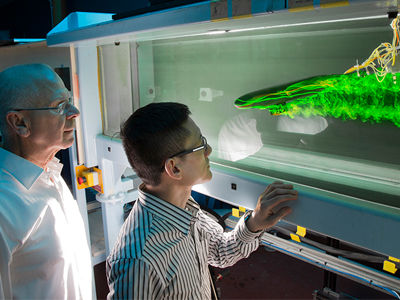Flow visualisation improving future submarine research

DST Group researchers are undertaking a comprehensive study of the flow characteristics around modern submarine geometries to improve their understanding of these complex flow phenomena.
The research program involves the use of high-fidelity computational-fluid-dynamics (CFD) methods, as well as extensive experimental hydrodynamic and aerodynamic testing of a generic shape that is representative of a modern diesel-electric powered submarine.
Dr Soon-Kong Lee is among a team of engineers and scientists from DST and the Australian Maritime College, who are undertaking this exciting new research.
“A 1.35 metre long model of a generic (Joubert BB1) submarine has been tested in the DST low-speed wind tunnel over several years, and now for the first time a smaller version of the model is being tested in the DST water tunnel using dye-visualisation techniques,” Lee said.
“The purpose of these dye-visualisation tests is to obtain some understanding of the flow structures produced in water by the submarine.”
“Coloured fluorescent dye is introduced into the model via a string support and leaves through strategically located ports over the surface of the model. The dye allows us to clearly see the flow structures that are being produced.”
The release of the dye is captured in still images and on video, and the technique and results look promising.
Australian Navy Submarines
Insights from the water-tunnel tests add to the database of knowledge already compiled for this generic submarine shape, and can provide a source of comparative data for computational testing of the same configuration.
Dr Lee is working alongside DST Honorary Fellow Dr Lincoln Erm, an expert in dye visualisation with many years of experience with the water-tunnel equipment.
“It’s fantastic working with Dr Erm; at this early stage it’s more of a qualitative analysis, getting an idea of the kind of flow structures that may be present during a manoeuvre for this geometry which hasn’t been studied in this way before,” Lee says.
“The water tunnel gives us a level of clarity and detail that is not easily obtained in a large-scale wind tunnel.”
This fascinating research is already seeing value with the water-tunnel dye visualisation contributing to a much larger body of work that DST is undertaking in support of the Australian Navy submarines' SEA-1000 program.

